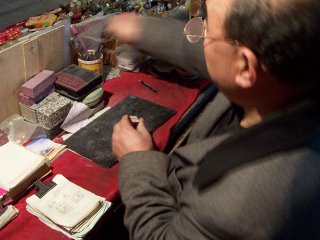At 5am, after 3 hours of sleep, we got up and started checking out of the foreign students’ dormitory at Fudan University. By the way, did you know that dorm houses almost as many people as all of Union College? Interesting. Anyway, I left my big rolling suitcase in storage there, filled to the brim with stuff bought in China, and not much else. In my backpack are clothes for the next three weeks traveling. Professor Ferry showed up at 6am with a van, as well as her husband Danielle (also a professor at Union) and their 4-year-old son Camille. They speak only Spanish with Camille so that he will grow to be bilingual, and I understand about as much of what they say as I do Chinese. After listening to Chinese for 3 months, Spanish sounds like English with a really thick accent. Anyway, I had been hoping to get a solid three hours of sleep on the plane to add to the four that I got in bed, but thanks to a charming little Chinese girl who sat behind me passed the time by kicking my seat, I only got about half an hour.
We landed in Chengdu in fog thick enough that I could not see the ground until we were on it. That was a little startling. As I write this two days later, the weather hasn’t changed much. It’s about 40-50F and as damp as it can possibly be. Feels just like November in Rochester. Sky, our tour guide, tells us that the weather here is so damp because the entire province of Sichuan is in a basin surrounded by mountains, which I imagine are very beautiful, if only I could see them. The upside to the dampness is the vegetation, which is so lush it looks almost tropical.
This tour is different from the Xin Jiang trip because we have our own private tour guide and bus driver. Though Camille’s energy is enough to replace the 40 Chinese tourists from the Xin Jiang trip, it’s still a much better arrangement. We can adjust the itinerary of the trip as we wish, skipping the stuff we know will be a waste of time.
The other major difference is the food. Sichuan is notorious for the food, which is amazing, especially if you like it spicy. The Sichuanese have a saying about their food. It sounds a lot more poetic in Chinese, but the translation is “I’m not afraid the food will be spicy, I’m afraid it won’t be spicy.”
Being so much further inland, the people here don’t have as much exposure to western culture and people. This basically means two things: more staring, and more spitting. However, they make up for both ten times over with one endearing quality. In Chengdu, people have a remarkable ability to drive their bikes, cars, trucks, and buses without laying on the horn every two seconds. It’s amazing how quiet a bustling city can sound.

The first tour stop after lunch was a Daoist temple, which was essentially the same as many of the other 10 we’ve visited. Behind the temple was a nice little park, where an ‘old people’s club’ had gathered. The old men gathered in groups of 4 or 5 around Mahjong and Chinese Chess games, where the spectators would study the board and give advice to the two players as they saw fit. Walking a little further on, we found old women dancing in pairs to the revolutionary songs being played by a small, ad-hoc band and chorus of more elderly men. Some of the men in the chorus were OK singers, but most were delightfully out of tune, and the guy with the wooden flute squeaked every four or five notes. Regardless, the energy was definitely there, helped along by a woman conducting the ensemble and an energetic old man half dancing half marching in place in front of them all. It was hard to tell if they were practicing for a performance or just singing and playing for fun, but I don’t think it mattered much. Every one of them was smiling from ear to ear. If ever a group of people truly earned there retirement, it’s these people. They endured Japanese occupation during World War II, fought the civil war during the Communist Revolution, suffered ten years through the Cultural Revolution, and worked hard every day in between. Almost every day of their life has been difficult. Now the state supports their hard-earned retirement, and nobody appreciates it more than they do.













